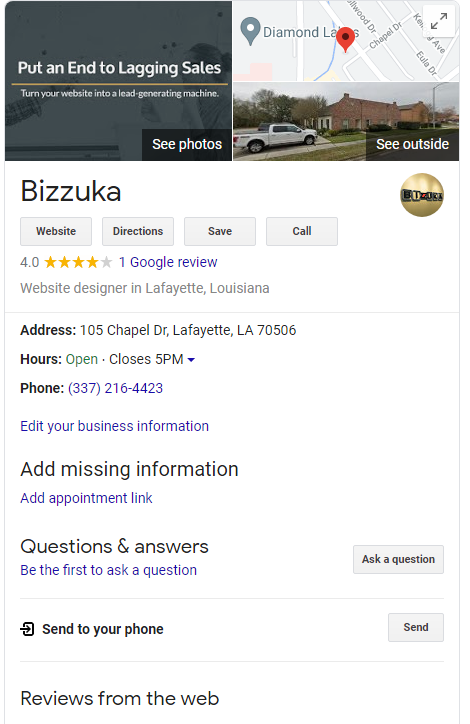After a year of a seemingly endless closing and reopening cycle, it’s safe to say that no business owner would mind getting a little extra traffic these days.
It’s time to make up for all that you lost last year by improving your online presence and attracting more customers.
But first, you’ll need to understand the necessary components of good online visibility.
Google My Business
If you don’t already have a Google My Business listing, this is where you should start.
Not sure what this is or whether you have one or not?
Take a second to google the name of your business.
Does anything show up on the right hand side of the search results? If yes, and it looks like the image below, you’re in luck–you have a claimed Google listing.
If there’s a little bit of information on the right and you see “Own this business?” towards the bottom of the listing, you will need to claim it.
If there’s nothing on the right, you’ll need to create a listing here.
The highest-ranking Google listings are fully optimized. Your listing should include every possible detail about your business, including pictures, categories, hours, and more.
Bing Places for Business
Bing has its own version of search engine listings: Bing Places for Business. While this may be shocking to hear, some people still actually use Bing, and you will need to manually add your listing here too. This process is almost identical to adding a Google listing, and claiming and fluffing it out is equally as important.
Linkbuilding
Listing and claiming your business in online directories like YellowPages and Yahoo will give you more credibility online. The more directories you’re listed in, the easier it is for your customers to find you.
It’s important to note that all of your directory listings should consist of the exact same phone number, address, and business name. Any inconsistencies will throw Google off and confuse potential customers.
Reputation Management
Your business needs to be available for customers to review. As long as you have a Google My Business listing, it’ll be available for review on Google–but this shouldn’t be the only place. You’ll need to generate positive reviews on Facebook, Yelp, and industry-specific sites in order to improve your visibility.
It’s not enough to simply generate these reviews, however. You’ll also need to respond to them–regardless of whether they’re positive or negative.
This is referred to as reputation management, and how you choose to handle negative feedback will speak volumes to your potential customers. These responses will increase your engagement rate, improving your overall online presence. Hell, it may even make some of the negative reviewers change their reviews and give you another chance.
Social Media
Facebook is essentially its own search engine, and social media platforms are really just more directories for you to list your site, get reviews, and interact with customers. Depending on your industry, Instagram, Twitter, LinkedIn, Tik Tok, and YouTube can all be great places to create an account and boost your online presence. The more platforms you’re on, the greater your visibility will be.
Mobile Responsivity
Mobile traffic has been on a steady incline for quite some time now. That being said, if your site isn’t mobile-responsive yet, you’re shooting yourself in the foot.
Nobody wants to stay on a website that doesn’t fit the screen they’re looking at it on. Because of this, Google decreases the ranking of sites that aren’t mobile-friendly. In fact, when generating your rankings, it actually looks at your mobile site first.
Improving your online presence doesn’t have to be so complicated. When you schedule a free 45-minute strategy session with Bizzuka, we can help you discover the holes in your current digital marketing approach and how to fix them. Check out our blog for more tips on SEO and marketing.

